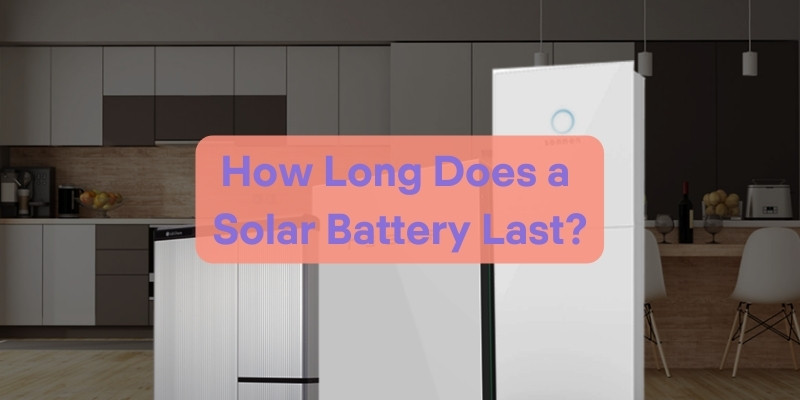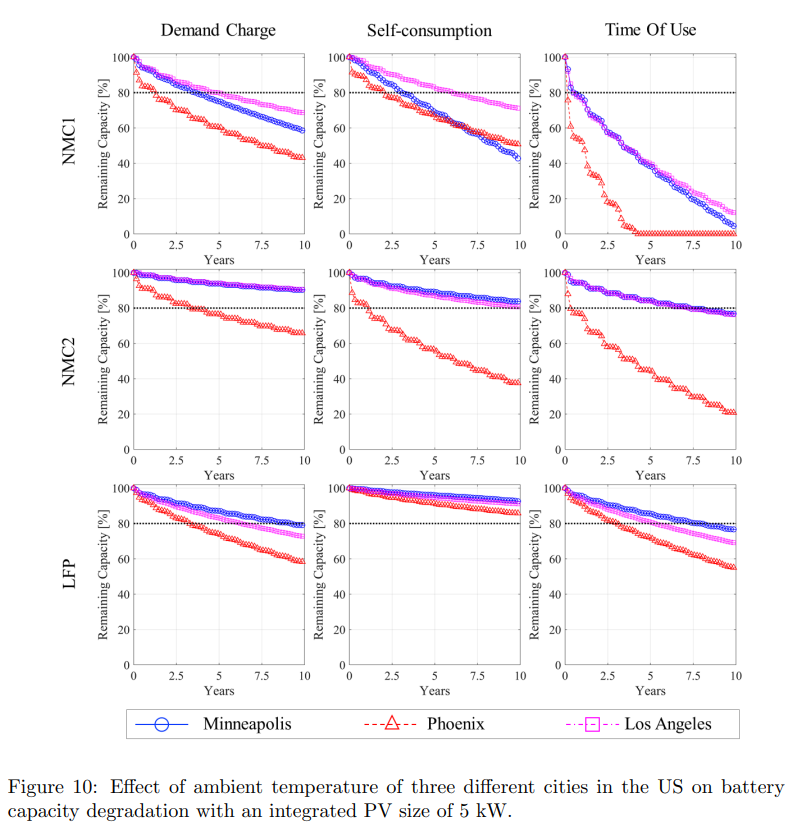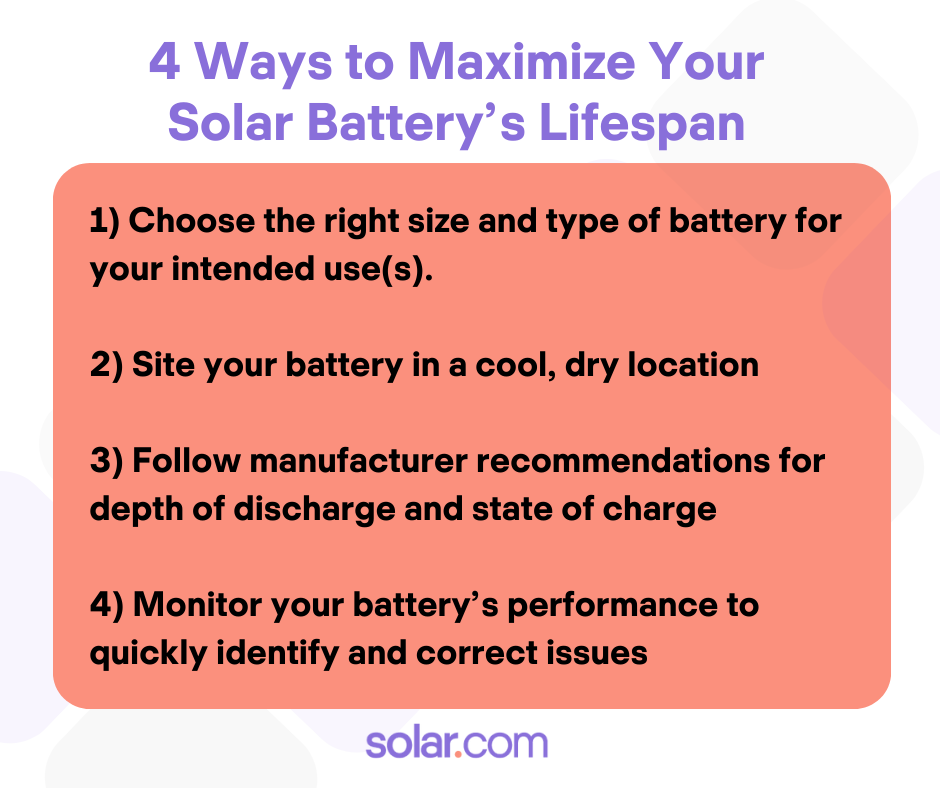
When you install a home battery, you’re gaining a backup energy reserve in the case of an outage.
Whether you have a solar panel system at your home or not, a home battery can be used to store electricity and deliver it to your home appliances and devices. The benefits of a home battery are clear, especially during short or long-term outages, and in areas with Time-of-Use (TOU) rates or weak net metering policies.
In this article, we’ll show you how to calculate how a solar and battery system can power your house during a grid outage, and give you some tips for maximizing your battery usage.
Did you know? With the “One Big Beautiful Bill” signed into law, installing solar and/or battery storage in 2025 is homeowners’ last chance to claim a 30% federal tax credit. Start your project today to lock in a 2025 installation date and your home’s full savings potential.
How long can a solar battery power a house?
Without running AC or electric heat, a 10 kWh battery alone can power the critical electrical systems in an average house for at least 24 hours, and longer with careful budgeting. When paired with solar panels, battery storage can power more electrical systems and provide backup electricity for even longer.
In fact, a recent study by the Lawrence Berkeley National Laboratory found that when heating and cooling are excluded:
“(A) small PVESS with just 10 kWh of storage (at the lower end of sizes currently observed in the market) can fully meet backup needs over a 3-day outage in virtually all U.S. counties and any month of the year.”
PVESS stands for photovoltaics and energy storage systems.
But exactly how long you can power your home with solar battery storage varies for each home and depends on three main things:
- Your battery storage capacity
- The output of your solar system
- Your electricity needs during an outage
We’ll show you how to budget your electricity to meet your solar and battery capacity below. First, let’s start with identifying your battery storage capacity.
Home battery capacity
Capacity — the amount of energy a battery can store — is one of the main features that influence how long a battery can power a house during a power outage.
Battery capacity is measured in kilowatt-hours (kWh) and can vary from as little as 1 kWh to 18 kWh. Multiple batteries can be combined together to add even more capacity, but a 10 kWh home battery is typical for most homes.
Related reading: What Size Solar Battery Do I Need?
During a power outage, assuming you have a fully charged home battery, you will be able to use most of the 10 kWh of stored energy. However, depending on the battery type, you’ll want to leave a minimum charge of 5-10% on your battery for a couple main reasons:
- To maintain the health of your battery
- To start your solar inverters in the morning so you can recharge your battery with solar power
For a 10 kWh battery, you’ll want to leave at least 1 kWh of capacity in reserve at all times. That leaves you with 9 kWh of battery capacity to power your home during a grid outage.
Related reading: The 8 Best Solar Batteries (and How to Choose the Right One For You)
Solar system output
The beauty of pairing battery storage with solar is that you essentially create your own miniature utility to power your home. This is especially useful during prolonged power outages because unless you have battery storage, your solar system will be turned off by the local utility to prevent the backflow of electricity from injuring workers trying to repair the grid.
But if you have battery storage, your system can operate independently when the grid is down. This is called “islanding.”
How much electricity does a solar system produce?
Solar panel systems are measured in kilowatts (kW) which represent the amount of energy the system can produce in an hour of peak sunlight. So a 5 kW solar system can produce 5 kWh of electricity per hour in ideal conditions. However, since conditions aren’t always ideal, we typically assume a performance ratio of 75%.
The average number of peak sunlight hours per day varies from 3.5 to 5.5 in the US. Multiply the system capacity by sunlight hours and 0.75 to find the daily output of a solar system.
For example, here’s how you would find the daily output of a 5 kW solar system getting 4.5 peak sunlight hours per day equals:
5 kW solar system x 4.5 sunlight hours per day x 0.75 performance rating = 16.875 kWh per day
In many cases, that’s more than enough to power essential electrical systems and recharge a 10 kW battery to use overnight. But electricity needs vary from home to home, so let’s run through some common appliances and how much energy they use.
Your electricity needs during a power outage
How long solar battery storage can run your home depends on how much electricity you use. And how much electricity you use depends on which appliances and systems you’re running.
During a power outage, it’s recommended to budget electricity for the most necessary things first and then make a plan for the remainder of the capacity. For many homeowners, the list of priorities includes:
- Refrigerator
- Kitchen and cooking
- Water heating
- Lights
- TV and device charging
It’s worth noting that heating and cooling take a ton of energy, and typically aren’t configured to be powered by critical battery backup systems. Whole home backup is possible, but it takes a large solar system with around 30 kWh of battery storage.
Let’s run through an example scenario of powering essential systems during a 24-hour power outage to get an idea of how much solar and battery capacity you’ll need.
Use the tables below as an a la carte menu to create your own battery storage budget.
Refrigerator: 1.5 kWh per day
| Model | Energy use |
| Older 15-cubic foot unit (1996) | 5 kWh per day |
| Newer ENERGY STAR 17-cubic foot unit | 1.16 kWh per day |
A refrigerator is among the most important things to power during an outage so that you can avoid having your food and drink go to waste.
If you have a modern, ENERGY STAR-approved model, your refrigerator is using around 1-2 kWh of electricity a day. If your fridge lived through Y2K, you might be looking at closer to 5 kWh per day.
Refrigerator electricity usage can be minimized by opening the door less and raising the temperature slightly. If you are preparing for a planned Public Safety Power Shutoff (PSPS), set the temperature very low before the shutoff event, and then set it to a higher temperature once the grid power goes out. That way the fridge starts cold and you can devote less battery capacity to power it during the outage.
Let’s say you have a relatively modern ENERGY STAR-certified fridge that uses 1.5 kWh per day.
Running total: 1.5 kWh
Kitchen and cooking: 1 kWh per day
| Appliance | Energy use |
| Electric oven | 2.3 kWh per hour |
| Oven: surface | 1 -1.5 kWh per hour |
| Microwave oven | 0.12 kWh per 5 minutes |
| Coffee maker |
0.12 kWh per brew / 0.4 kWh per hour on warmer
|
| Dishwasher (energy saver cycle) | 0.5 kWh per load |
| Toaster | 0.04 kWh per use |
Even during a power outage, people gotta eat. And in a large enough outage, it may not be practical to eat out or order delivery.
Let’s say you make a pot of coffee and toast in the morning (0.2 kWh), microwave some leftovers for lunch (.12 kWh), and bake a frozen pizza for dinner (0.75 kWh) because you’re trying to clear out the freezer. That amounts to just over 1 kWh throughout the day.
Running total: 2.5 kWh
Electric water heating: 2.5 kWh a day
| Appliance | Energy use |
| Electric water heater | 4-5 kWh per day (running 2-3 hours) |
| Heat pump water heater (50-75 gallon) | ~2.5 kWh per day |
Water heating accounts for an average of 18% of the total energy used in the household, or around 162 kWh per month. On a normal day, a water heater runs for around 2 to 3 hours a day, which means that it will consume roughly 4-5 kWh of electricity a day. Heat pump water heaters are more efficient and can run on around 2.5 kWh per day.
But power outages are not normal days. To save electricity, you may want to skip or shorten your shower, wash your hands and rise your dishes with cold water, and hold off on laundry for a day or two.
And if you have a gas-powered water heater, water heating is a non-issue in terms of battery use.
But for the sake of argument, let’s say you put on some extra deodorant and limit your water heating use to 2.5 kWh per day.
Running total: 5 kWh
Lights: 1 kWh per day
| Bulb type | Energy use |
| CFL/LED (8 W) equivalent to 25 W incandescent | 0.008 kWh per hour |
| CFL/LED (15 W) equivalent to 60 W incandescent | 0.015 kWh per hour |
| CFL/LED (27 W) equivalent to 100 W incandescent | 0.027 kWh per hour |
| CFL/LED (38 W) equivalent to 150 W incandescent | 0.038 kWh per hour |
Compared to larger appliances, lights require very little electricity, especially if you have compact fluorescent (CFL) or LED bulbs. Even at the high end, a 38W LED bulb or 150 W incandescent bulb uses just 0.038 kWh per hour.
So if you budget 1 kWh of battery storage per day for lighting, you could run 26 bulbs for 1 hour each — more than enough to provide light for trips to the bathroom, closet, and getting ready for bed.
Running total: 6 kWh
TV and device charging: 2 kWh
| Device | Energy use |
| WiFi router | 0.024 kWh per day |
| Modern TV: LED/OLED 4k or 1080P HDTV (20″ to 70″+) | 0.014 to 0.18 kWh per hour |
| TV: Plasma (40″ to 50″+) | 0.4 to 0.48 kWh per hour |
| Desktop computer | 0.06 kWh per hour |
| Laptop computer | 0.02-0.05 kWh per hour |
| Tablet | 0.032 kWh per day |
Let’s be honest, one of the worst parts of power outages is going without internet and TV. Sure, you try to read a book for an hour or two, but that familiar glow is calling your name.
To keep the WiFi on, you’ll need about 0.024 kWh. If you work from home, you can run your laptop for 8 hours for another 0.4 kWh. And if you want to wind-down with a movie or 3-hour Netflix binge, you’ll need another 0.54 kWh.
That adds up to 1.18 kWh, but we’ll round up to 2 kWh to account for phone charging and multiple devices running at once.
Running total: 8 kWh
Air Heating and Cooling: Variable
| Appliance | Energy use |
| Heating | |
| Electric furnace (with fan) | 10.5 kWh per hour |
| Portable heater | 1.5 kWh per hour |
| Baseboard heater (6-foot unit) | 1.5 kWh per hour |
| Cooling | |
| Window/Wall AC (8k to 18k BTU) | 0.73 to 1.8 kWh per hour |
| Central AC (3 ton – 12 SEER) | 3.0 kWh per hour |
| Pedestal fan | 0.03 kWh per hour |
| Ceiling fan | 0.025-0.075 kWh per hour |
As you can see from the table, heating and cooling take a lot of electricity. So if you only had a 10 kWh battery you’d have maybe 2 kWh to budget for running fans or space heaters — which wouldn’t last very long at all.
To power heating and cooling for a substantial period of time, you typically need two or three batteries that add up to 30-40 kWh of backup capacity.
Medical equipment
| Device | Energy use |
| Nebulizer | 1 kWh per hour |
| Oxygen concentrator | 0.46 kWh per hour |
| Sleep apnea machine (CPAP) | 0.2 kWh per hour |
Another thing to consider is powering medical equipment during a power outage. Certain equipment, like a nebulizer, requires a significant amount of electricity and could eat through 10kWh of battery very quickly.
Is getting a solar battery worth it?
Weather-related power outages in the US increased roughly 78% from 2011 to 2021, and are becoming a reality for more homeowners. If you like clean, quiet, and hands-free backup energy that can power your home for several days during outages, then solar and battery are totally worth it. Not only can a battery keep your home powered, it can keep your local grid running, as we saw in California in September 2022.
And, of course, there are the local and global impacts of reducing fossil fuels that pollute the air and contribute to climate change.
Compare bindings quotes for solar and battery systems to backup your home.




